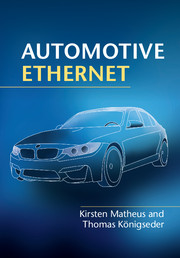Book contents
- Frontmatter
- Contents
- Preface
- Abbreviations
- Timeline
- 1 A brief history of “Ethernet” (from a car manufacturer’s perspective)
- 2 A brief history of in-car networking
- 3 A brief history of Automotive Ethernet
- 4 The physical transmission
- 5 Protocols for Automotive Ethernet
- 6 Ethernet in automotive system development
- 7 Outlook
- Index
- References
5 - Protocols for Automotive Ethernet
Published online by Cambridge University Press: 05 December 2014
- Frontmatter
- Contents
- Preface
- Abbreviations
- Timeline
- 1 A brief history of “Ethernet” (from a car manufacturer’s perspective)
- 2 A brief history of in-car networking
- 3 A brief history of Automotive Ethernet
- 4 The physical transmission
- 5 Protocols for Automotive Ethernet
- 6 Ethernet in automotive system development
- 7 Outlook
- Index
- References
Summary
One of the reasons for the automotive industry to adopt Ethernet-based communication as an in-car networking system is the chance for synergies, i.e. the possibility of reusing protocols that have been developed and tested in other applications. Across the various protocol layers for the various applications it therefore needs to be carefully investigated whether to adopt, adapt, or to add protocols. Figure 5.1 gives an example overview of the protocol stack. This chapter discusses three areas that require special care: how to adopt and potentially adapt Audio Video Bridging (AVB, see Section 5.1); how to use the Internet Protocol (IP) and Virtual LANs (VLANs, see Sections 5.2 and 5.3); and what is needed in terms of command and control (see Section 5.4). Be aware that there might be other solutions that work. The described solutions make no claim to be complete; nevertheless they do work.
Quality of Service (QoS) and Audio Video Bridging (AVB)
Ethernet as such, i.e. the PHY and MAC layers as defined by IEEE 802.3, provide best-effort traffic only. Going to “full-duplex,” in the sense of switched Ethernet networks, improved the determinism of each individual link, since a number of units no longer needed to contend for the same medium at potentially the same time and have to go into random, i.e. non-deterministic, back-off periods. However, in a switched network, data of different sources with different destinations might have to be sent over the same link at the same time. It is therefore in the switch – often also referred to as a bridge – that many QoS requirements can effectively be supported. Today, it is mainly at IEEE 802.1 that the respective standards are being developed. The following sections will give some background information on the standards’ activity (Section 5.1.1), and enlighten the differences between the originally envisioned use cases and automotive deployment (Section 5.1.2). In return, this allows describing how each QoS standard can best be used in in-car networking (Section 5.1.3), before the efforts of how to go beyond the QoS for audio and video are described (Section 5.1.4).
Information
- Type
- Chapter
- Information
- Automotive Ethernet , pp. 134 - 174Publisher: Cambridge University PressPrint publication year: 2014
